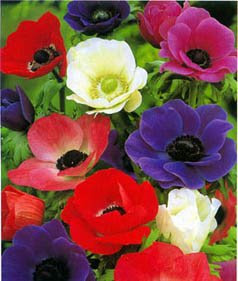Anemones grow wild in many European countries, in North America, and Japan. Anemones are closely related to Pasque flower (Pulsatilla) and Hepatica (Hepatica); some botanists include both of these genera within the genus Anemone.

The name Anemone comes from Greek and roughly means wind flower, which signifies that the wind that blows the petal open will also, eventually, blow the dead petals away.

- The Anemone plants are perennial herbs with an underground rootstock, and radical, more or less deeply cut leaves.
- The elongated flower stem bears one or several, white, red, blue or rarely yellow flowers. There is an involucre of three leaflets below each flower.
- The fruits often bear long hairy styles, which aid their distribution by the wind. They produce cup-shaped yellowish, white, purple, violet, or red Anemone flowers.
- Among the most popular are the autumn-flowering Japanese Anemone(Anemone hupehensis).
- Yellow wood anemone (Anemone ranunculoides), also known as the Buttercup Anemone, is a similar plant with slightly smaller flowers of rich yellow colouring.
- Kingdom
- Plantae
- Division
- Magnoliophyta
- Class
- Magnoliopsida
- Order
- Ranunculales
- Family
- Ranunculaceae
- Genus
- Anemone


